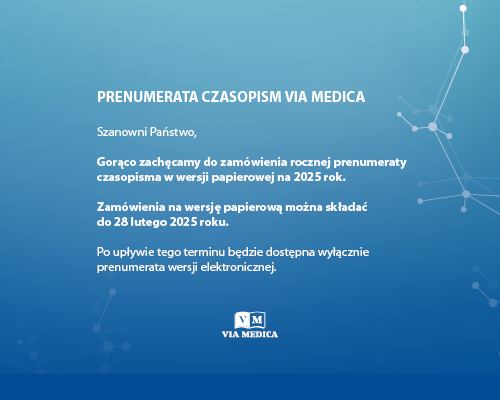Tom 11, Nr 2 (2018)
Sprawozdanie z konferencji / Sprawozdanie
Opublikowany online: 2018-09-07
Wyświetlenia strony
399
Wyświetlenia/pobrania artykułu
618
Wybrane zagadnienia dotyczące inaktywacji biologicznych czynników chorobotwórczych w składnikach krwi w świetle doniesień prezentowanych na 35. Międzynarodowym Kongresie International Society of Blood Transfusion w Toronto, 2–6 czerwca 2018 roku
Journal of Transfusion Medicine 2018;11(2):72-74.
Streszczenie
Podczas Międzynarodowego Kongresu International Society of Blood Transfusion (ISBT), który odbył się w Toronto (Kanada) w dniach 2–6 czerwca 2018 roku, podobnie jak w latach poprzednich wiele uwagi poświęcono metodom inaktywacji biologicznych czynników chorobotwórczych w składnikach krwi. Zagadnienia te szczegółowo omówiono podczas sesji plenarnych i plakatowych. Na sesji plenarnej wygłoszono pięć wykładów dotyczących inaktywacji.
Słowa kluczowe: Wybrane zagadnienia
Referencje
- Devine DV. Pathogen Inactivation Strategies to Improve Blood Safety: Let's Not Throw Pathogen-Reduced Platelets Out With Their Bath Water. JAMA Oncol. 2018; 4(4): 458–459.
- Allain JP, Owusu-Ofori AK, Assennato SM, et al. Effect of Plasmodium inactivation in whole blood on the incidence of blood transfusion-transmitted malaria in endemic regions: the African Investigation of the Mirasol System (AIMS) randomised controlled trial. Lancet. 2016; 387(10029): 1753–1761.
- Klein-Bosgoed C, Schubert P, Devine DV. Riboflavin and ultraviolet illumination affects selected platelet mRNA transcript amounts differently. Transfusion. 2016; 56(9): 2286–2295.
- Osman A, Hitzler WE, Meyer CU, et al. Effects of pathogen reduction systems on platelet microRNAs, mRNAs, activation, and function. Platelets. 2015; 26(2): 154–163.
- van Rhenen DJ, Vermeij J, Mayaudon V, et al. Functional characteristics of S-59 photochemically treated platelet concentrates derived from buffy coats. Vox Sang. 2000; 79(4): 206–214.
- Picker SM, Speer R, Gathof BS. Functional characteristics of buffy-coat PLTs photochemically treated with amotosalen-HCl for pathogen inactivation. Transfusion. 2004; 44(3): 320–329.
- Johnson L, Loh YS, Kwok M, et al. In vitro assessment of buffy-coat derived platelet components suspended in SSP+ treated with the INTERCEPT Blood system. Transfus Med. 2013; 23(2): 121–129.
- Schubert P, Culibrk B, Karwal S, et al. Whole blood treated with riboflavin and ultraviolet light: quality assessment of all blood components produced by the buffy coat method. Transfusion. 2015; 55(4): 815–823.
- Estcourt LJ, Malouf R, Murphy MF. Pathogen-Reduced Platelets for the Prevention of Bleeding in People of Any Age. JAMA Oncol. 2018; 4(4): 571–572.
- Cancelas JA, Slichter SJ, Rugg N, et al. Red blood cells derived from whole blood treated with riboflavin and ultraviolet light maintain adequate survival in vivo after 21 days of storage. Transfusion. 2017; 57(5): 1218–1225.
- Cancelas JA, Gottschall JL, Rugg N, et al. Red blood cell concentrates treated with the amustaline (S-303) pathogen reduction system and stored for 35 days retain post-transfusion viability: results of a two-centre study. Vox Sang. 2017; 112(3): 210–218.
- Saadah N, Schipperus M, Wiersum-Osselton J, et al. Comparing clinical use: effectiveness, and risk across transfusion from fresh frozen plasma to solvent/detergent plasma in the Netherlands. Vox Sang. 2018; 113 (1): 5–347. (p. 33).
- Cameron M, Waters L, Padula M, et al. Combining UVC-Pathogen inactivation and Cold-storage : a nowel approach to improve platelet safety and extend the shelf — life. Vox Sang. 2018; 113 (1): 5–347. (p. 33).
- Kumukova I, Trakhtman P, Starostin N, et al. Comparison of laboratory parameters of pathogen reduced and irradiated RBC suspension. Vox Sang. 2018; 113 (1): 5–347. (p. 169).





